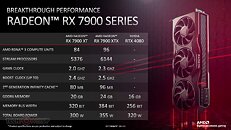- Joined
- Oct 9, 2007
- Messages
- 47,301 (7.52/day)
- Location
- Hyderabad, India
| System Name | RBMK-1000 |
|---|---|
| Processor | AMD Ryzen 7 5700G |
| Motherboard | ASUS ROG Strix B450-E Gaming |
| Cooling | DeepCool Gammax L240 V2 |
| Memory | 2x 8GB G.Skill Sniper X |
| Video Card(s) | Palit GeForce RTX 2080 SUPER GameRock |
| Storage | Western Digital Black NVMe 512GB |
| Display(s) | BenQ 1440p 60 Hz 27-inch |
| Case | Corsair Carbide 100R |
| Audio Device(s) | ASUS SupremeFX S1220A |
| Power Supply | Cooler Master MWE Gold 650W |
| Mouse | ASUS ROG Strix Impact |
| Keyboard | Gamdias Hermes E2 |
| Software | Windows 11 Pro |
AMD in its technical presentation confirmed the reference clock speeds of the Radeon RX 7900 XTX and RX 7900 XT RDNA3 graphics cards. The company also made its first reference to a GeForce RTX 40-series "Ada" product, the RTX 4080 (16 GB), which is going to launch later today. The RX 7900 XTX maxes out the "Navi 31" silicon, featuring all 96 RDNA3 compute units or 6,144 stream processors; while the RX 7900 XT is configured with 84 compute units, or 5,376 stream processors. The two cards also differ with memory configuration. While the RX 7900 XTX gets 24 GB of 20 Gbps GDDR6 across a 384-bit memory interface (960 GB/s); the RX 7900 XT gets 20 GB of 20 Gbps GDDR6 across 320-bit (800 GB/s).
The RX 7900 XTX comes with a Game Clocks frequency of 2300 MHz, and 2500 MHz boost clocks, whereas the RX 7900 XT comes with 2000 MHz Game Clocks, and 2400 MHz boost clocks. The Game Clocks frequency is more relevant between the two. AMD achieves 20 GB memory on the RX 7900 XT by using ten 16 Gbit GDDR6 memory chips across a 320-bit wide memory bus created by disabling one of the six 64-bit MCDs, which also subtracts 16 MB from the GPU's 96 MB Infinity Cache memory, leaving the RX 7900 XT with 80 MB of it. The slide describing the specs of the two cards compares them to the GeForce RTX 4080, which is what the two could compete more against, especially given their pricing. The RX 7900 XTX is 16% cheaper than the RTX 4080, and the RX 7900 XT is 25% cheaper.

View at TechPowerUp Main Site
The RX 7900 XTX comes with a Game Clocks frequency of 2300 MHz, and 2500 MHz boost clocks, whereas the RX 7900 XT comes with 2000 MHz Game Clocks, and 2400 MHz boost clocks. The Game Clocks frequency is more relevant between the two. AMD achieves 20 GB memory on the RX 7900 XT by using ten 16 Gbit GDDR6 memory chips across a 320-bit wide memory bus created by disabling one of the six 64-bit MCDs, which also subtracts 16 MB from the GPU's 96 MB Infinity Cache memory, leaving the RX 7900 XT with 80 MB of it. The slide describing the specs of the two cards compares them to the GeForce RTX 4080, which is what the two could compete more against, especially given their pricing. The RX 7900 XTX is 16% cheaper than the RTX 4080, and the RX 7900 XT is 25% cheaper.

View at TechPowerUp Main Site






 .
.